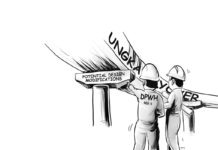
[av_one_full first min_height=” vertical_alignment=” space=” custom_margin=” margin=’0px’ padding=’0px’ border=” border_color=” radius=’0px’ background_color=” src=” background_position=’top left’ background_repeat=’no-repeat’ animation=”]
[av_heading tag=’h3′ padding=’10’ heading=’EDITORIAL | Early action’ color=” style=’blockquote modern-quote’ custom_font=” size=” subheading_active=’subheading_below’ subheading_size=’15’ custom_class=”][/av_heading]
[av_textblock size=” font_color=’custom’ color=”]
Monday, April 17, 2017
[/av_textblock]
[av_textblock size=” font_color=” color=”]
THE SERIES of recent strong earthquakes in Luzon and Mindanao were wakeup calls for all of us to be constantly vigilant. Strong temblors cause fear but it is important that we keep ourselves aware of what to do to be safe. We are reminded that the increasing frequency and magnitude of earthquakes highlight the need for early action.
Earthquakes turn into major disasters due to unsafe structures — poorly built structures, buildings in inappropriate places, inadequate design and materials specification, and shortcuts in construction. Inspection during the construction of both public and private infrastructure is important. The additional expense required for making structures safe from earthquakes is worth it especially if it would save thousands of precious lives.
The government must ensure that all structures, especially bridges, school buildings and hospitals, are earthquake-proof through the conduct of a nationwide structural evaluation and by retrofitting these structures to allow them to withstand destructive earthquakes.
In Western Visayas, there was some relief when, during the last presentation of Phivolcs chief Undersecretary Renato Solidum, a possible 8.2 magnitude had been downgraded because of the movement of the Negros Trench in the past few years. Every year, there’s an earthquake and the pressure built at the Negros Trench has been expended.
In Metro Manila, however, Phivolcs says the Marikina Valley Fault Line is ripe for movement and no one can predict the exact time when it will move. This makes preparedness for such eventuality even more important. An earthquake study of the Japan International Cooperation Agency in 2004 revealed that a 7.2-magnitude earthquake in Metro Manila would destroy 40 percent of residential buildings, damage 35 percent of public buildings, kill 34,000 people, injure 114,000 individuals, and the ensuing fires will also result in 18,000 additional fatalities.
The study also contained priority actions – the promotion of disaster-resilient urban development; ensuring the structural integrity of buildings and critical infrastructure; formulating emergency supply system of water, food and other necessities; and determining open spaces for safe refuge when tremors occur.
Preparedness against earthquakes in all parts of the country cannot be overemphasized.
[/av_textblock]
[/av_one_full]



